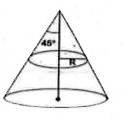The semi-vertical angle of a cone is 45∘ . If the height of the cone is 20.025, then its approximate laternal surface area, is
401√2π
400√2π
399√2π
none of these
The correct Answer is:A
To find the approximate lateral surface area of a cone with a semi-vertical angle of 45∘ and a height of 20.025, we can follow these steps:
Step 1: Understand the Geometry of the Cone
Given that the semi-vertical angle is 45∘, we can deduce that the radius R of the cone is equal to its height H. This is because in a right triangle formed by the radius, height, and slant height, if the angle is 45∘, then:
H=R
Step 2: Use the Pythagorean Theorem
The slant height L can be calculated using the Pythagorean theorem:
L2=H2+R2
Since H=R, we can substitute R with H:
L2=H2+H2=2H2
Thus,
L=H√2
Step 3: Define the Lateral Surface Area Formula
The formula for the lateral surface area S of a cone is given by:
S=πRL
Substituting R and L in terms of H:
S=πH(H√2)=πH2√2
Step 4: Substitute the Height
Given that the height H is 20.025, we can express S as:
S=π(20.025)2√2
Step 5: Calculate S
First, calculate 20.0252:
20.0252=400.100625
Now substitute this value into the equation for S:
S=π⋅400.100625⋅√2
Step 6: Approximate the Change in Height
To find the approximate change in lateral surface area due to a small change in height, we denote the change in height as ΔH=0.025. We need to find the derivative of S with respect to H:
dSdH=2πH√2
Now evaluate this at H=20:
dSdH∣∣∣H=20=2π(20)√2=40π√2
Step 7: Calculate the Change in Surface Area
The change in surface area ΔS can be calculated as:
ΔS=dSdH⋅ΔH=40π√2⋅0.025=π√2⋅1
Step 8: Final Approximate Lateral Surface Area
Now, we can find the approximate lateral surface area:
Sapprox=S+ΔS
Substituting the values we have:
Sapprox=π⋅400√2+π√2=π√2(400+1)=401π√2
Conclusion
Thus, the approximate lateral surface area of the cone is:
401π√2
Given that the semi-vertical angle is 45∘, we can deduce that the radius R of the cone is equal to its height H. This is because in a right triangle formed by the radius, height, and slant height, if the angle is 45∘, then:
The slant height L can be calculated using the Pythagorean theorem:
The formula for the lateral surface area S of a cone is given by:
Given that the height H is 20.025, we can express S as:
First, calculate 20.0252:
To find the approximate change in lateral surface area due to a small change in height, we denote the change in height as ΔH=0.025. We need to find the derivative of S with respect to H:
The change in surface area ΔS can be calculated as:
Now, we can find the approximate lateral surface area:
Thus, the approximate lateral surface area of the cone is:
Topper's Solved these Questions
- DIFFERENTIALS, ERRORS AND APPROXIMATIONSBOOK - OBJECTIVE RD SHARMA ENGLISHCHAPTER - DIFFERENTIALS, ERRORS AND APPROXIMATIONSEXERCISE - Exercise
17 Videos
- DIFFERENTIALS, ERRORS AND APPROXIMATIONSBOOK - OBJECTIVE RD SHARMA ENGLISHCHAPTER - DIFFERENTIALS, ERRORS AND APPROXIMATIONSEXERCISE - Exercise
17 Videos
- DIFFERENTIAL EQUATIONSBOOK - OBJECTIVE RD SHARMA ENGLISHCHAPTER - DIFFERENTIAL EQUATIONSEXERCISE - Chapter Test
30 Videos
- DIFFERENTIATIONBOOK - OBJECTIVE RD SHARMA ENGLISHCHAPTER - DIFFERENTIATIONEXERCISE - Chapter Test
30 Videos
Similar Questions
If the semivertical angle of a cone is 45∘. Then the rate of change of its volume is
View SolutionThe semi-vertical angle of a cone remains constant. If its height increases by 2%, then find the approximate increase in its volume.
View SolutionWater is dropped at the rate of 2 m3/s into a cone of semi-vertical angle is 45∘ . If the rate at which periphery of water surface changes when the height of the water in the cone is 2m is d. Then the value of 5d is _____ m/sec
View SolutionWater is dropped at the rate of 2 m3/s into a cone of semi-vertical angle is 45∘ . If the rate at which periphery of water surface changes when the height of the water in the cone is 2m is d. Then the value of 5d is _____ m/sec
View SolutionA ring of mass m and radius R rests in equilibrium on a smooth cone of semi-vertical angle 45∘ as shown. The radius of the cone is 2R. the radius of circular cross section of the ring is r(r<<R).

What will be the tension in the ring?
View SolutionThe height of a cone increases by k% its semi-vertical angle remaining the same. What is the approximate percentage increase (i) in total surface area, and (ii) in the volume, assuming that k is small?
View SolutionThe height of a cone increases by k% its semi-vertical angle remaining the same. What is the approximate percentage increase (i) in total surface area, and (ii) in the volume, assuming that k is small?
View SolutionThe curved surface area of a cone is 12320cm2. If the radius of its base is 56 cm, find its height.
View SolutionWater is dropped at the rate of 2m2/s into a cone of semivertical angel of 45∘. The rate at which periphery of water surface changes when height of water in the cone is 2 m, is
View SolutionThe diameters of two cones are equal. If their slant heights are in the ratio 5:4, find the ratio of their curved surface areas.
View Solution
